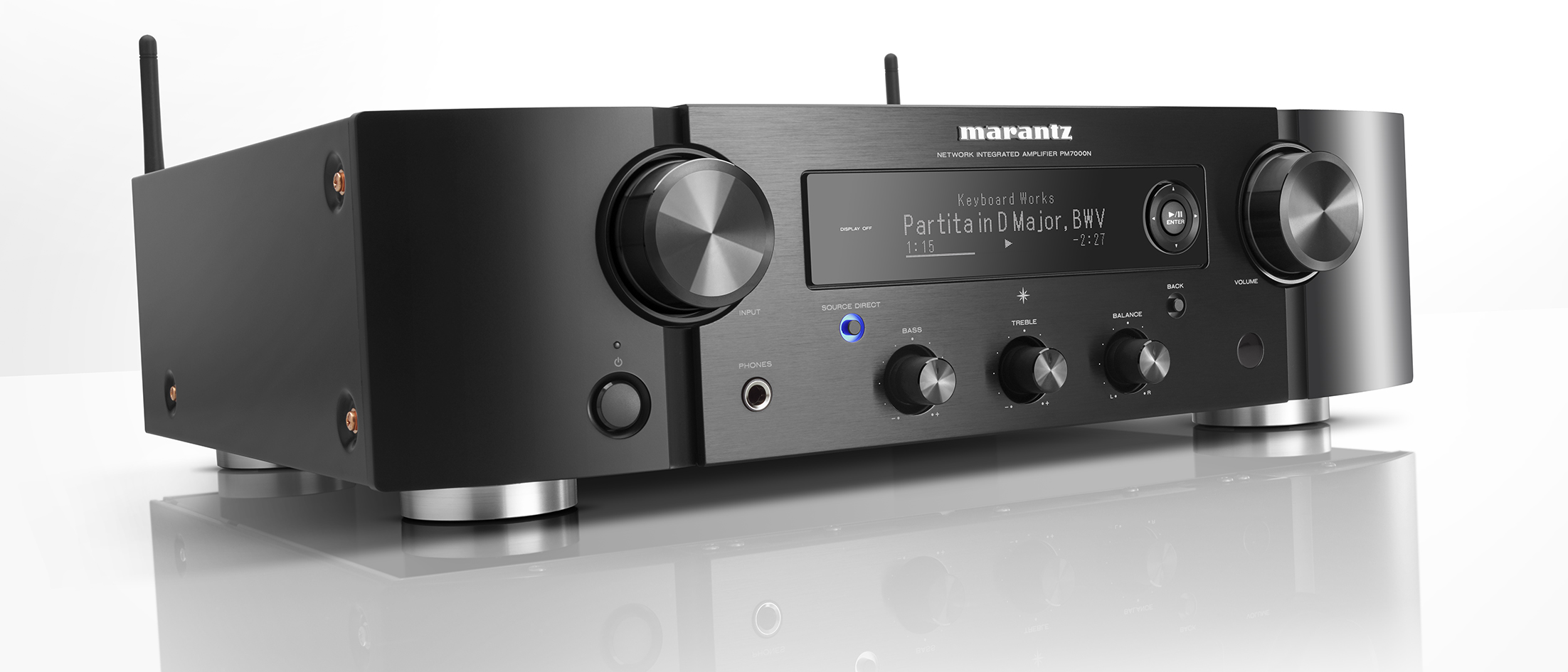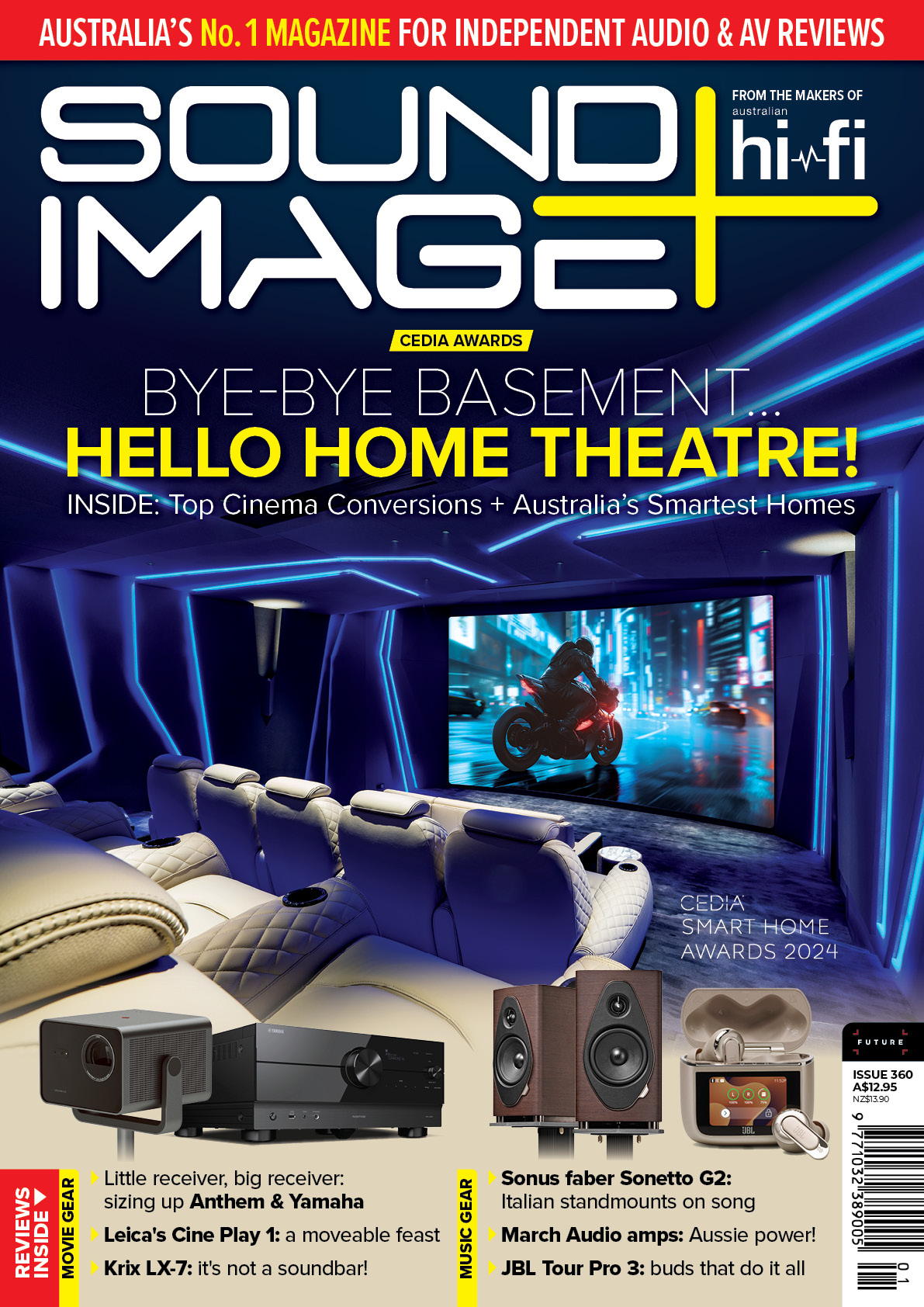Sound+Image Verdict
At first glance, a solid but standard stereo amplifier. But inside, a thoroughly modern Marantz, offering streaming, networking and multiroom on top of the solid sound fundamentals for which the company is famed.
Pros
- +
Solid amplifier fundamentals
- +
Full HEOS and multiroom support
- +
Good phono stage
Cons
- -
Bluetooth SBC only
Why you can trust What Hi-Fi?
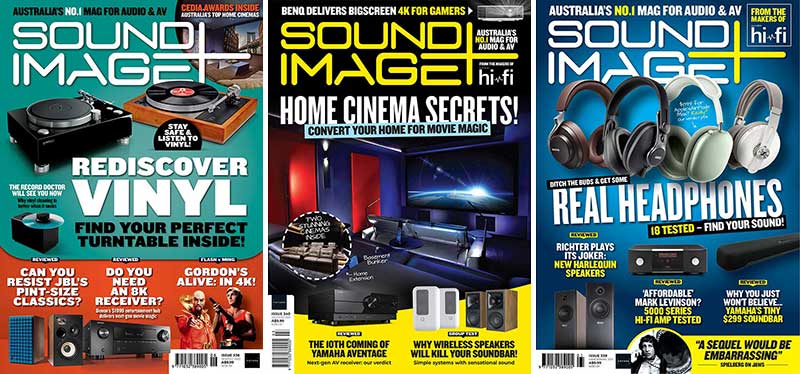
This review originally appeared in Sound+Image magazine, one of What Hi-Fi?’s Australian sister publications. Click here for more information on Sound+Image, including digital editions and details on how you can subscribe. Read What Hi-Fi?'s global, star-rated Marantz PM7000N review.
It seems a thoroughly traditional amp in appearance, the Marantz PM7000N, with tone controls and everything – just the kind of product Marantz has delivered as the powerhouse for hi-fi stereo separates systems if not since Saul Marantz began soldering his first Consolette back in 1952, then at least since Marantz’s subsequent rebirth under Philips in the 1980s.
But this would be to make the schoolboy error of judging a book by its cover. Within its purposeful shell the PM7000N is not only a solid 60W-per-channel stereo amplifier, but also a network and internet streamer courtesy of HEOS, the streaming and multiroom platform belonging to Sound United, shared between Denon and Marantz, and at least partially developed here in Australia.
So the PM7000N is just as much the modern smart amplifier as those boxes which might advertise the fact of their modernity via large colour LCD screens of artwork, or by snazzy ‘all-in-one’ styling.
While this Marantz looks like a trad two-channel amp, with just a three-line OLED display to share its information, this is nevertheless also a potential ‘just-add-speakers’ solution. And the PM7000N has the advantage of delivering these modern merits within the type of amplifier design that Marantz has been perfecting for decades.
Equipment
In essence, then, this is an amplifier which combines 60W per channel of amplification with a DAC for digital inputs, and a network module which delivers access to a host of music streaming services.
Its range of physical inputs is solid, if more biased towards the traditional than those of new-age hi-fi. They do not, for example, extend to HDMI ARC for TV connection, to USB-B for a computer, nor XLR for balanced connections. But you get four analogue inputs – three of them at RCA line level, and the last a moving-magnet phono stage, newly-designed with a field-effect transistor in its input stage, the high input impedance of which Marantz says simplifies the path, eliminating the need for
AC coupling capacitors.
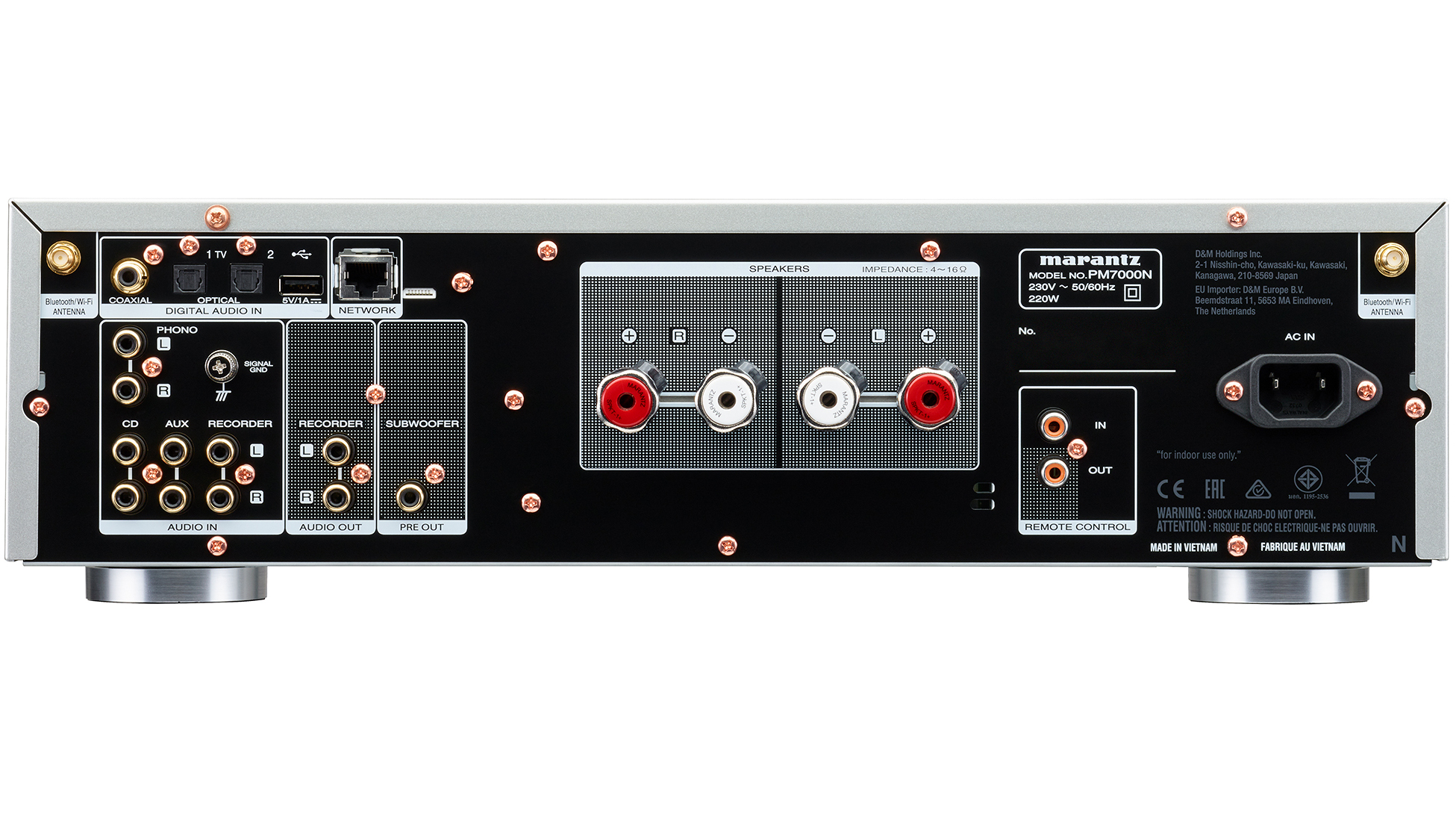
Unusually these days, perhaps again showing the legacy effect of the company’s longterm amplifier design, the last of the analogue line-level inputs is labelled ‘Recorder’, and has an associated analogue output at a fixed level, not variable for use as a ‘pre out’.
So you can easily record from the PM7000N, more likely to a digital recorder these days than a looped-through cassette deck or reel-to-reel. It’s something which amps with only pre-outs make difficult or impossible. A subwoofer output is also provided on a single RCA socket.
On the digital side there are two optical digital inputs and one coaxial, plus a USB-A slot to which drives or sticks of files can be attached. All these, including the USB-A slot and networked access to shared files, are limited to a maximum of 24-bit 192kHz PCM, or 5.6MHz DSD. The stated DAC for this model is the Asahi-kasei AK4490EQ DAC, supply of which has been affected not by Covid but by the disastrous AKM factory fire in Japan.
Consequently, Sound United locally has told us, “newer units rolling out of the factory now have a similar-spec DAC chipset with the same performance. No matter which DAC is used in the end, the sound master will go through rigorous sound tuning processes using premium components to achieve that signature sound that Marantz is known for.”
That’s a reasonable position, and certainly there’s more to sound than just the DAC, though the DAC equally certainly does make a difference. As it happens, this amplifier’s performance from analogue inputs made it clear that it’s the amplifier’s fundamentals which are the star turn here anyway, not the digital performance and DAC. Hence the change of DAC may even improve things.
Streaming
The last digital input is Bluetooth streaming. This is limited to the SBC codec, with neither AAC support for Apple device users nor anything up the aptX chain for those with Android devices which support it. But once the PM7000N is networked, you’ll have workarounds for that. Android users can use the HEOS app to play music from their own device, or use a third-party UPnP-enabled app (like mConnect) to stream high-res files. Apple users have AirPlay 2 for direct streaming, which is far superior to Bluetooth.
The HEOS app also opens up access to Spotify (paid or free, controlled via the Spotify app), and to paid access from Tidal, Amazon Music and Deezer, and free music from Soundcloud, TuneIn internet radio, and iHeartRadio. The operation within the HEOS app is generally relatively primitive compared with the native apps – Tidal, for example, is navigated by folders rather than screens of album-art tiles – but this implementation has the advantage that the music flows direct from the internet to the Marantz, with your device merely controlling the music choice.
The alternative is to use the native Tidal app on your device, then throw the result to the Marantz by selecting it as Tidal’s output path. It doesn’t appear under the initial list of Chromecast devices, but can be accessed under ‘AirPlay & Bluetooth’ devices; again Apple device owners have the quality of AirPlay while Android users are stuck with only SBC Bluetooth, so would take a significant quality hit via this path.
When we tried A-B listening to Tidal via HEOS versus Tidal via AirPlay 2 from an iPad Pro, there was very little indeed to pick between the streams – perhaps a fraction more detail and bass definition to the HEOS stream, but marginal. There’s no MQA onboard the Marantz to enable Tidal Masters streaming with their purported high resolution, otherwise the direct stream would have that advantage over the AirPlay path.
The absence of Qobuz support actually leaves HEOS without a high-res streaming service option other than Amazon HD, which isn’t available in Australia, or again via the workaround of third-party UPnP apps. But there are indications that other services will be accommodated in future. The Marantz is certainly high-res capable to 24-bit/192kHz via digital inputs and network streaming.
Performance
We gave the PM7000N an Ethernet connection to our network (dual-band Wi-Fi is also available), and it pretty much set itself up, downloading a software update, installing it and then pronouncing itself ready to play. This delightfully easy set-up compensated for the previous hour we’d spent trying to work out how to remove the plastic bungs from the amp’s magnificently robust speaker connections, Marantz’s premium SPKT-1+ design (see below).
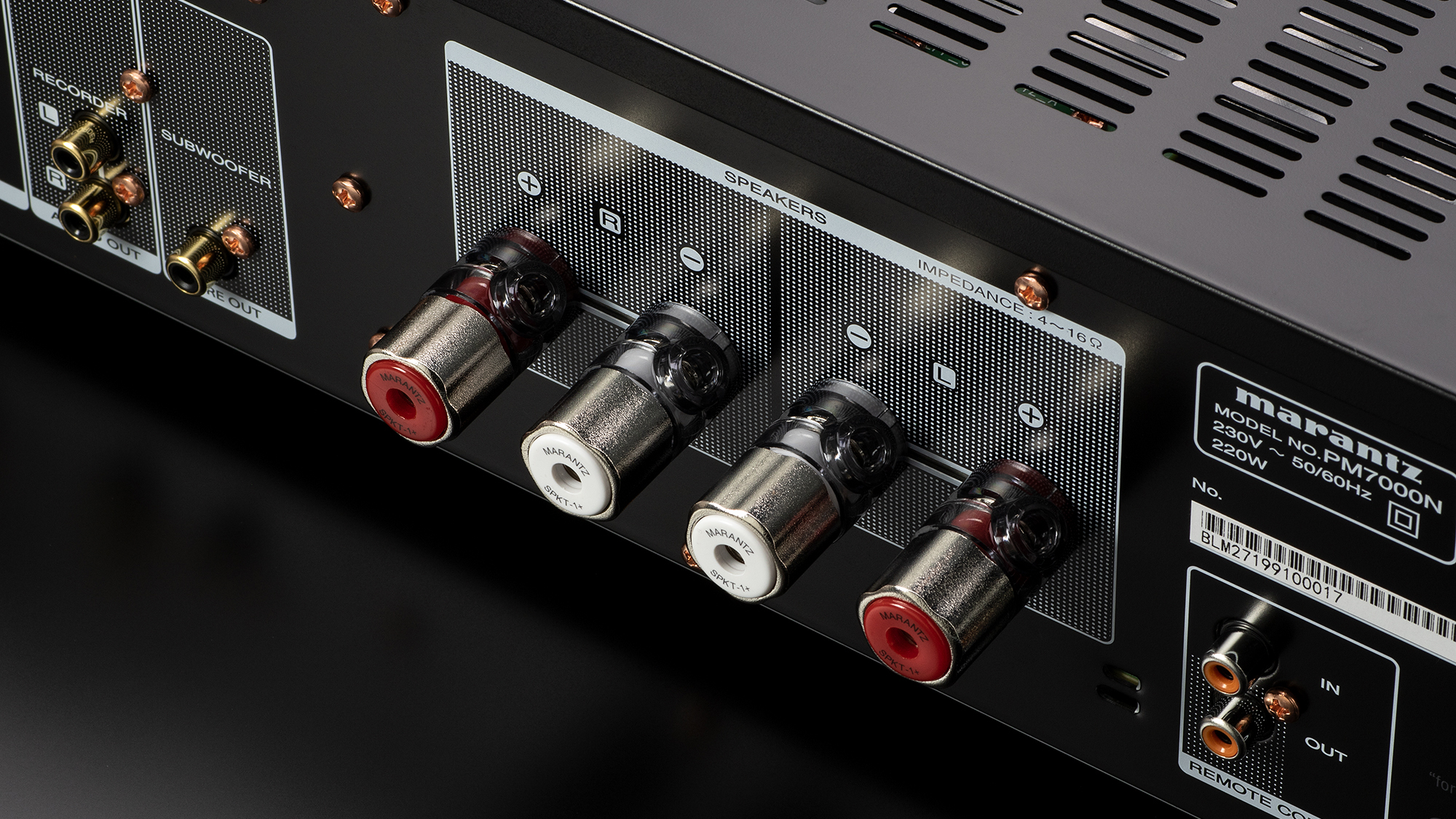
These are dense brass terminals with silver plating and hard plastic shielding, through which a hole allows clean connection of bare wires, while the terminals also accept spades. If, like us, you have banana plugs on your speaker cables, you’ll find their entrance blocked not by mere caps that can be prized off, but by long plastic inserts sitting relatively deep inside the terminal.
How to remove them? The printed manual suggests you screw the terminal fully clockwise then just shove in your banana plugs – perhaps the blockage moves cleverly out of the way, we thought, so we tried that with the first socket, and succeeded only in jamming the plastic insert in deeper. Eventually small tweezers extracted the other three, and we spent a final five minutes cork-screwing a gimlet into the socket to extract the one we’d jammed in.
All this is, we assume, to comply with Euro-regulations banning banana sockets. We’re not in Europe, and so rather resent this, particularly when no instructions or warning is given in the manual; the online version, indeed, which extends to 141 pages, actually removes any reference to banana plugs at all, implying only spades or bare wire should be used.
That little nightmare over, we were able to immediately enjoy the Marantz’s high quality amplification. We connected a Thorens turntable, plugged in our computer audio (via optical, using a USB-to-SPDIF converter), and we streamed from Tidal, Spotify and other services using the HEOS app and sometimes via AirPlay. But we started as purely as possible, playing high-res files from an attached USB stick.
And from the off it was clear this is a high quality amplifier, and that the quoted 60W into eight ohms (80W into four) was more than adequate for driving our reference speakers to high levels without distortion. Early up was the duet of Alone Again (Naturally) by Diana Krall and Michael Bublé at 24-bit/48kHz; it emerged as the epitome of smoothness, both vocals delicately and crisply edged without ever straying into sibilance, the arrangement spread smoothly like melting butter on a crumpet.
For rather more of a challenge we loaded a 2.8MHz DSD remaster of the single mix of Total Mass Retain from ‘Close to the Edge’ by Yes, every corner of the soundstage stuffed with detail and dynamics, and the PM7000N more than equal to it, kicking the doors down with its tight precision indeed, and happy to raise the impact levels as we turned it up.
The power behind this performance comes from Marantz’s own circuit technology, a Class-AB amplifier which maintains the current feedback Marantz has championed for more than 20 years over “less sophisticated” voltage feedback designs. By minimising negative feedback, this design simplifies the signal path and generates a low phase shift, reducing the need for phase compensation; Marantz points to a resulting rapid transient response and sonic transparency across the full bandwidth, while also making the power amplifier relatively insensitive to changing and difficult loudspeaker loads.
As with its PM6006, Marantz has chosen a shielded toroidal transformer here, as opposed to a less efficient E-I core. There are in fact two separate power supply circuits, with a digital switched-mode power supply active only when the unit is in standby, likely another legislative requirement to achieve a legal minimum standby power.
The newly-developed preamplifier section leverages Marantz’s latest electronic volume control together with the HDAM (Hyper Dynamic Amplifier Module) technology that’s been a key staple of Marantz kit since the 1990s, using discrete surface-mount components with short mirror-imaged signal paths; Marantz claims that HDAMs outperform integrated op-amps dramatically in terms of slew rate and noise level.
And while the network module and digital board are shielded to prevent interference, you can further purify playback by selecting ‘Source Direct’, to bypass the front-panel bass, treble and balance knobs. Such knobs are rare these days; tone controls are often banished somewhere within an app, and we very rarely invoke them anyway on a high quality amp like this. But they’re handy when you need them, as we did when playing some rather thin recordings of 1985’s Live Aid broadcast from the Internet Archive. A twist up of the bass and a notch down of the treble calmed and filled them out nicely.
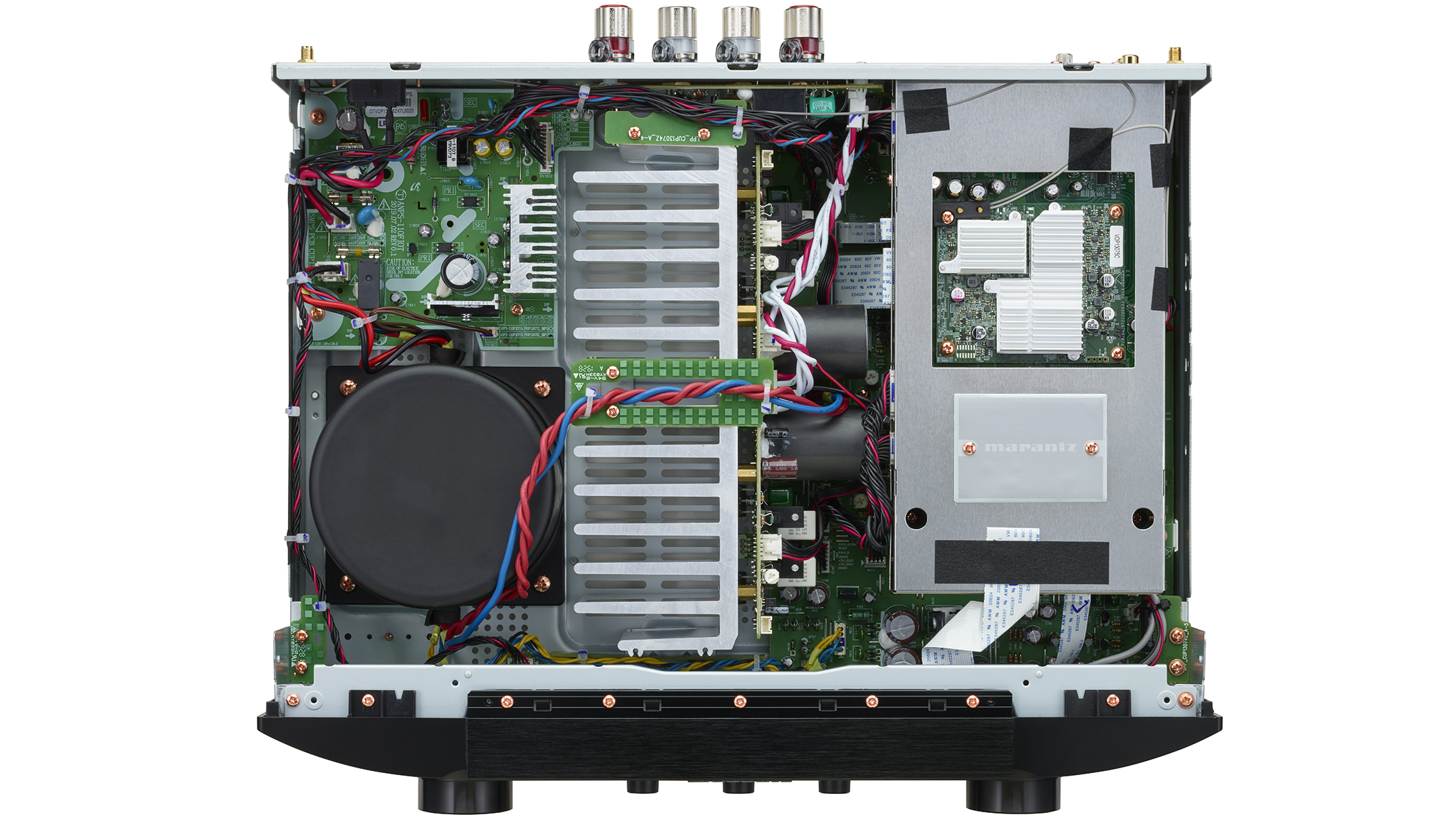
We punched in and out of ‘Source Direct’ regularly, but there was not the dramatic clarifying effect we’ve heard on some other gear. Such buttons on AV receivers can switch music from brash to smooth, from artificial to real, but here the performance was solid enough to begin with, and only small improvements were notable – though since it doesn’t even shut off the front-panel display there seems little penalty for leaving it invoked.
The manual also recommends three further “Pure Modes” which involve manually disabling Bluetooth and/or Wi-Fi and/or USB-A, should you not require their services.
We were particularly impressed with the phono stage, which performed above the level we’d expect in an amplifier of this price. In addition to a long run of old favourites, we played a fresh tri-colour pressing of the new Crowded House album ‘Dreamers Are Waiting’.
Despite the arguable pointlessness of enjoying a digitally-recorded album on vinyl, we quickly preferred the richness of delivery from the Thorens/Marantz combination over the Tidal stream. The phono circuit was as silent as we could hope between tracks, while the drums emerged full and tight, thumping and rolling nicely under the busy arrangement of Playing With Fire, Neil Finn’s vocal perfectly pitched at mid-depth of an expansive soundstage, before segueing into the almost Split-Enzian backing vocals of the first single To The Island.
Indeed we did develop a preference for the Marantz’s performance with analogue inputs over those going through its DAC. This was equally evident when we had a different streamer playing into its analogue inputs, revealing the additional quality available from the Marantz amplification when given the output of a higher-level DAC than its own.
There are a few hidden clevernesses too, which aid day-to-day operation. The amp can autosense an optical signal so that it turns on automatically with your TV. It’s theoretically able to be controlled by your TV remote for volume, power and input selection by learning the codes from the remote of your choice, which worked nicely with a Toshiba remote but stubbornly refused to learn anything from TCL or Samsung; go figure. And those interested in voice control can have Amazon Alexa, Google Assistant or, via AirPlay, Apple’s Siri assist them in various ways.
Final verdict
It looks like a plain amplifier, but the HEOS module inside makes the PM7000N as full of streaming abilities as those smart amps which declare their abilities more physically.
Meanwhile it delivers excellent sound quality at this price level from Marantz’s long-developed amplifier expertise. We once heard someone say that “Nobody ever regretted buying a current Marantz, unless it got stolen on the way home...”. This amplifier confirms that maxim’s pertinence once again.
Sound+Image is Australia's no.1 mag for audio & AV – sister magazine to Australian Hi-Fi and to the UK's What Hi-Fi?, and bestower of the annual Sound+Image Awards, which since 1989 have recognised the year's best hi-fi and home cinema products and installations. While Sound+Image lives here online as part of our group, our true nature is best revealed in the print magazines and digital issues, which curate unique collections of content each issue under the Editorship of Jez Ford, in a celebration of the joys that real hi-fi and high-quality AV can bring. Enjoy essential reviews of the most exciting new gear, features on Australia's best home cinemas, advice on how to find your sound, and our full Buying Guide based on all our current and past award-winners, all wrapped up with the latest news and editorial ponderings. Click here for more information about Sound+Image, including links to buy individual digital editions and details on how best to subscribe.
-
Battler009 Amazon HD is available in Australia now and can be used via HEOS for high resolution streaming, but Amazon is quite clunky to use vs Tidal via HEOSReply
